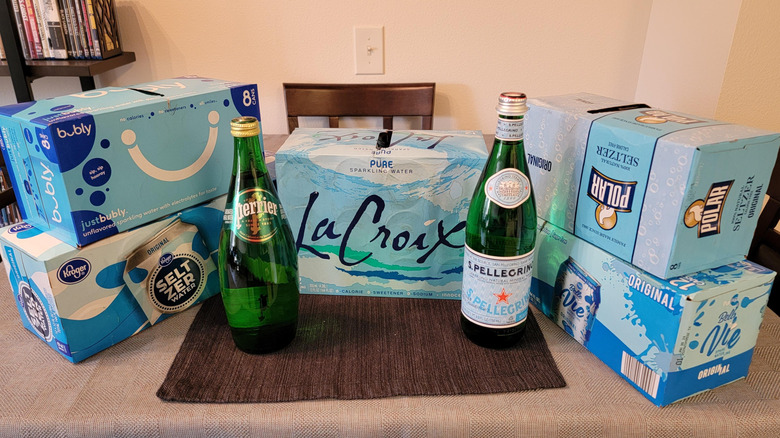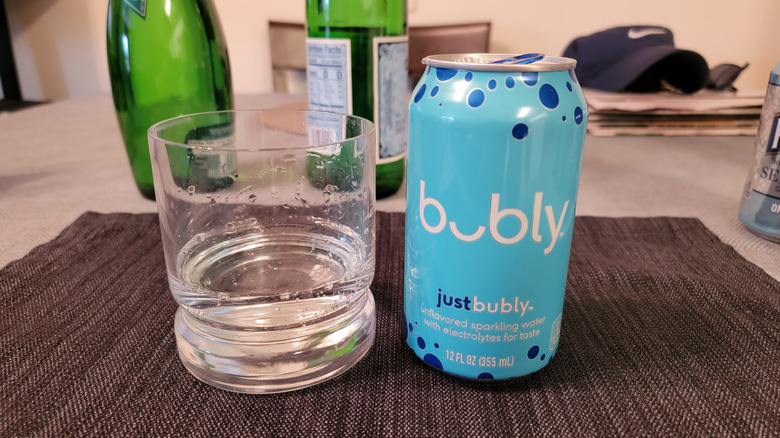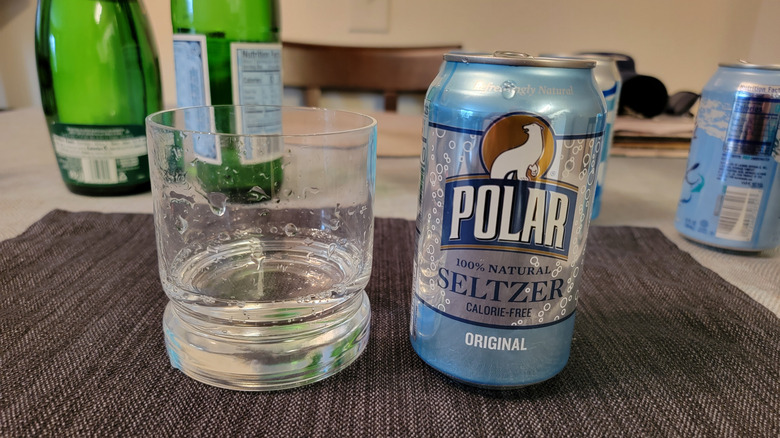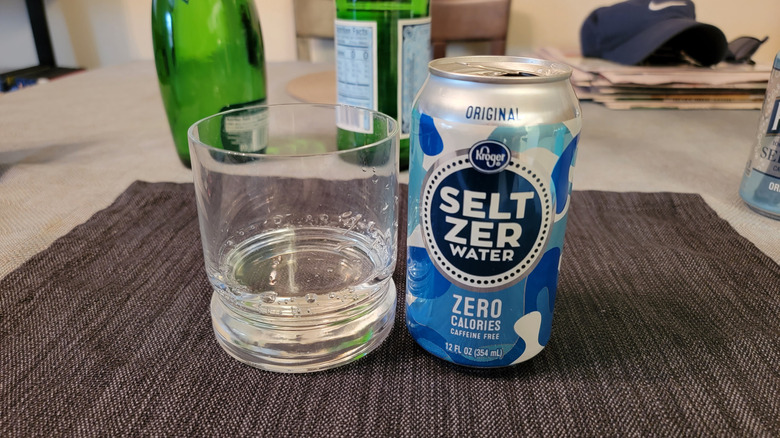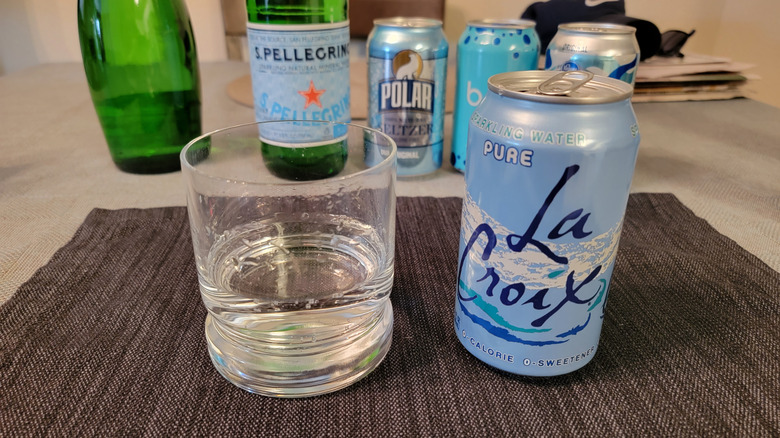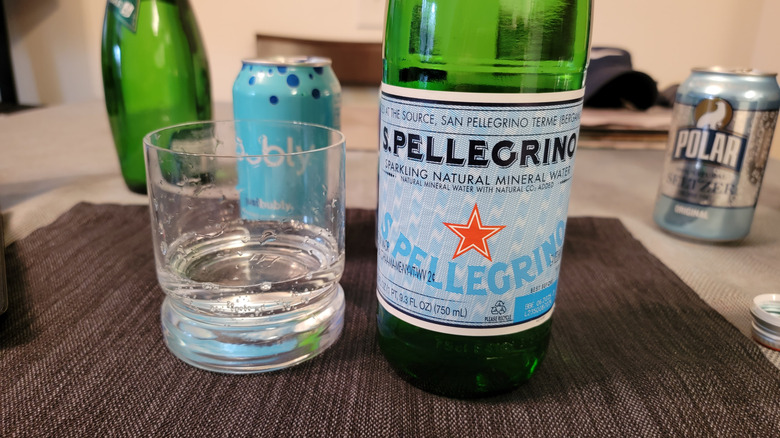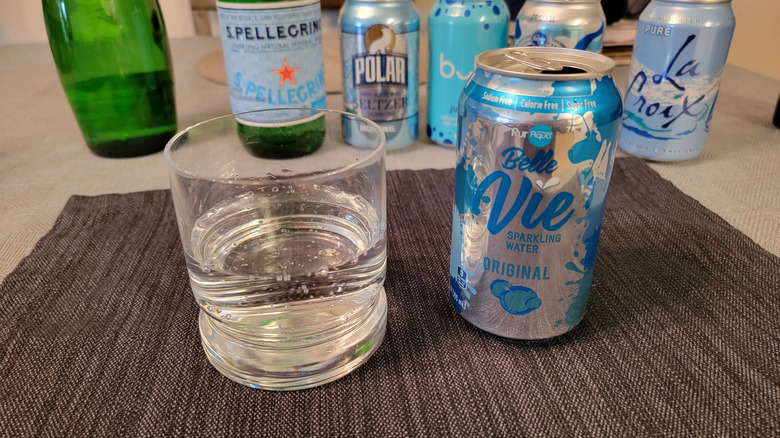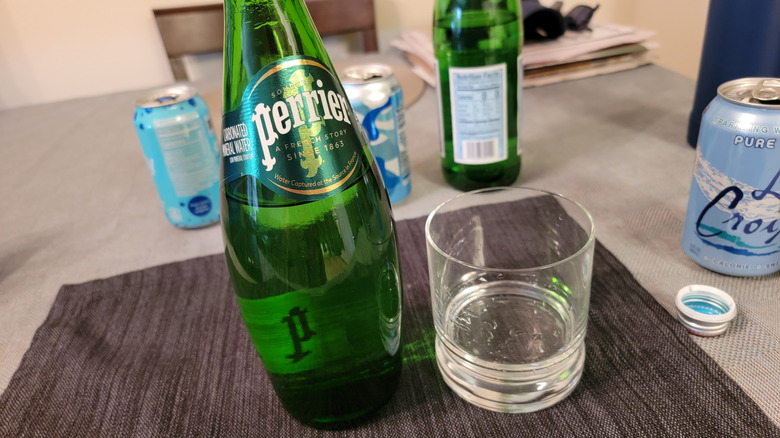7 Seltzers And Sparkling Waters, Ranked From Worst To Best
After two stints in college and a decade of writing, this the article I was made for: Hi, everyone. Today, I'll be ranking the taste of seven unflavored sparkling waters.
Seltzer water and sparkling drinks have seen a huge surge in popularity over the last few years, even within the adult beverage world. But, rather than debate the merits and cultural implications of White Claw, instead I'm going to focus on the most basic version of seltzer: Purified water, carbon dioxide, and maybe a stray mineral or two.
I've been drinking plain seltzer water at an unreasonable pace for years, and I've come to the surprising conclusion that some versions somehow taste better than others. Read on for a ranking of seven of the most widely available brands of fizzy water, along with a breakdown of their relative cost per can (as seen on Amazon.com or the Kroger and Aldi websites), so you can make the best choice.
7. Bubly
Cost: $1.27 per 12-oz. can
This is the only entrant on the list with anything other than some form of "carbonated water" listed among its ingredients. Bubly adds a pair of chlorides, potassium and calcium, which have a noticeable effect on the flavor. Frankly, it's not one I enjoy.
This tastes like a can of Sprite with all the sugar and fruit sucked out. It persists on the palate as well, and can even linger in the back of the throat. Add in the small eight-can packs and its vague tang, and this was the least pleasing pick of the bunch.
6. Polar
Cost: $0.39 per 12-oz. can
Polar and I are not friends. Look, the product itself is fine. There's a noticeable smoothness here, with well-rounded bubbles and a more tannic sensation than some of the products ranked later. It's kind of like someone mixed the Aldi and Kroger store brands in a glass and stirred the whole thing with a pool noodle dipped in chlorine.
But here's the thing I can't stomach: At most of my local grocers, Polar recently swapped out its 12-packs for eight-packs, without much of a reduction in price — shrinkflation at work. That's a 33% gouge to my fizzy water budget, and the flavor isn't good enough to warrant this cost for this sparkling water. Whether this is the fault of the producers or retailers, it's still not worth it.
5. Kroger
Cost: $0.33 per 12-oz. can
With the most aggressive carbonation of the bunch, Kroger's store-brand seltzer feels a bit like having ants on your tongue. When I first tried this one, I wasn't a fan. But as my recycling bin filled more and more quickly, and the price of fizzy water went up, I made a conscious decision: I would force myself to enjoy these blue-camo cans. And it worked!
I now look forward to the scouring burn, and it actually helps me drink the product more slowly. There's a definite mouthfeel here, and a texture that's lacking in Polar seltzer, also on this list. Perhaps that texture comes from its highest in-test sodium, clocking in at 15 mg per can (1% of the recommended daily value). My shifting personal tastes have made this a favorite over a few of the lower ranked entries. But I don't think its punchy seawater nature is for everyone.
4. LaCroix
Cost: $0.58 per 12-oz. can
LaCroix has, for the most part, held up as a popular seltzer option. As you'd expect from purified water, the flavor here is almost nonexistent. The texture is rather effervescent, disappearing off the tongue more quickly than most of the others. Still, there's a touch more carbonation than you'll find with Belle Vie (more on that later).
There's a reason LaCroix is so popular, with a drinking experience that's as soft as the color and design of the can. I'm also going to award extra points for visibility, since it's one of the easiest brands to find a natural flavor, without lemon, grapefruit, or other additives. If it weren't so damned expensive, my fridge might be full of LaCroix.
3. San Pellegrino
Cost: $1.04 per16.9-oz. bottle
I tried to find this stuff in cans but wound up with the classic green bottle instead (the unit price has been adjusted accordingly). San Pellegrino's flavor and textural profiles are strikingly similar to the Aldi brand, and I can see why Italians and others love it. It should also be noted that this is one of three entries not to feature zeroes across its nutrition label: San Pellegrino and Perrier both feature 60 milligrams of calcium, which is in line with their standing as "mineral water."
But San Pellegrino also adds 10 milligrams of sodium to the mix, which perhaps explains its interesting taste. I could talk about the relative evils of Nestlé, but I'll let you Google that topic for yourself. If you find yourself at an outdoor café with a plate of pasta before you, there are certainly worse things to drink.
2. Aldi's Pur Aqua Belle Vie
Cost: $0.35 per 12-oz. can
The most economical pick of the litter just narrowly misses out on the top spot. Indeed, Aldi's store brand is the undisputed champ around my house. The flavor of this flavorless liquid is beautiful: smooth, mild, and mouth-filling, with a perfect balance of carbonation. This stuff just tastes clean, and I could drink it by the gallon.
It also helps that it comes in at about half the price of LaCroix. The only problem is its availability. In each Aldi store I've visited, pallets of Belle Vie are more or less parked on the sales floor, with their various flavors intermixed. It's up to me, the consumer, to Jenga a few of these 12-packs out. But with a wonderful texture and price, I'm willing to put in the effort.
1. Perrier
Cost: $1.08 per 16.9-oz. bottle
Perrier was the last of the entrants I sampled. And yet, even with a belly full of water, the first sip came with an immediate realization: This feels the most like a beverage. Maybe it's the green bottle (again, no cans in my area), or perhaps the connection of mental circuits. This was the first brand of seltzer I became familiar with, thanks to a series of crime novels by Lawrence Block. The protagonist, Matthew Scudder, is a private detective and recovering alcoholic who sips Perrier in place of bourbon.
Regardless of my personal brain chemistry, though, the makeup of this liquid itself is pitch perfect. Its minerals and CO2 strike a balance between tannic and thirst quenching. Due to Perrier's high cost and Nestlé ownership, I generally go with the Aldi Belle Vie fizzy water, but in a vacuum, Perrier still holds the crown.
Now, if you'll excuse me, I have seven open containers of water on my table. Fortunately, my house plants are looking particularly thirsty.
